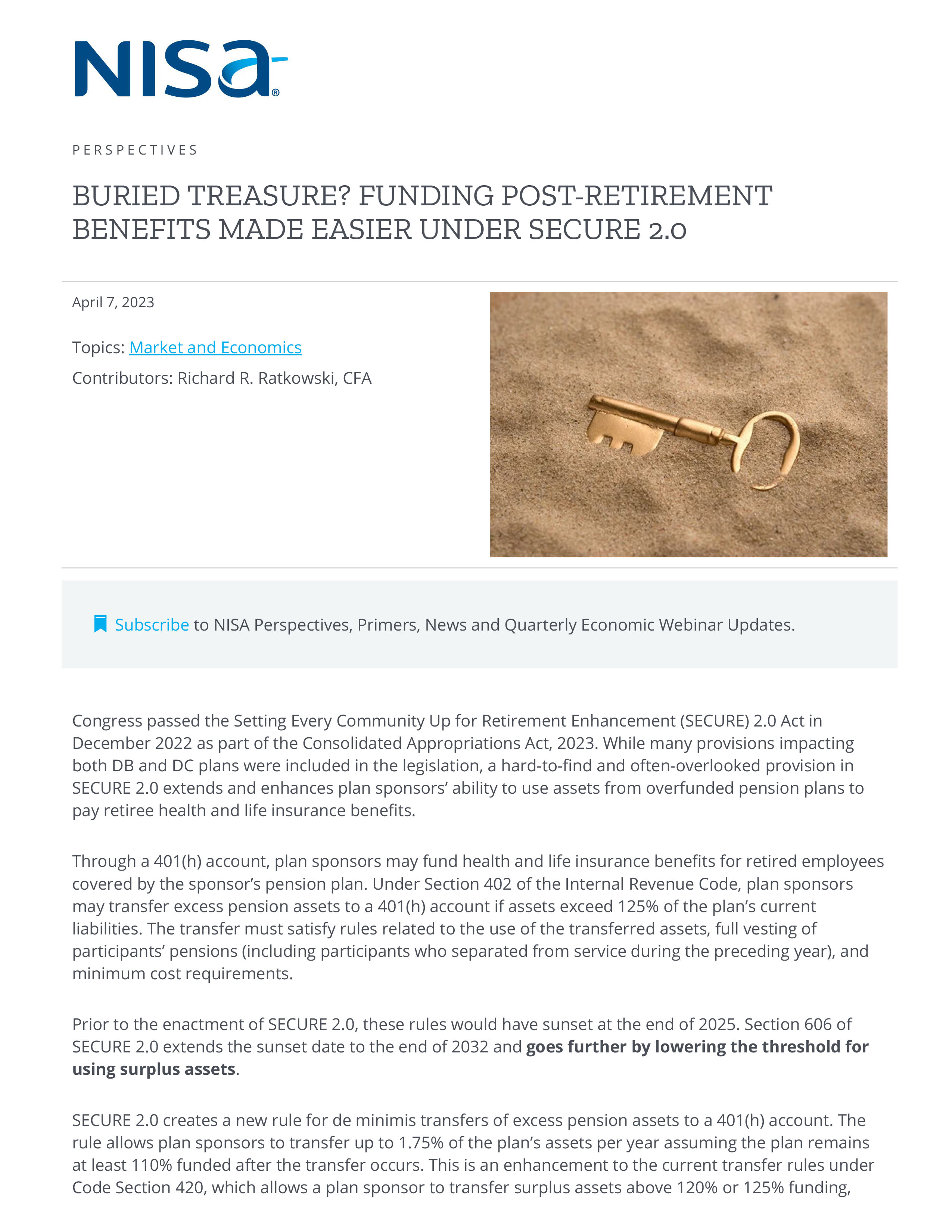Congress passed the Setting Every Community Up for Retirement Enhancement (SECURE) 2.0 Act in December 2022 as part of the Consolidated Appropriations Act, 2023. While many provisions impacting both DB and DC plans were included in the legislation, a hard-to-find and often-overlooked provision in SECURE 2.0 extends and enhances plan sponsors’ ability to use assets from overfunded pension plans to pay retiree health and life insurance benefits.
Through a 401(h) account, plan sponsors may fund health and life insurance benefits for retired employees covered by the sponsor’s pension plan. Under Section 402 of the Internal Revenue Code, plan sponsors may transfer excess pension assets to a 401(h) account if assets exceed 125% of the plan’s current liabilities. The transfer must satisfy rules related to the use of the transferred assets, full vesting of participants’ pensions (including participants who separated from service during the preceding year), and minimum cost requirements.
Prior to the enactment of SECURE 2.0, these rules would have sunset at the end of 2025. Section 606 of SECURE 2.0 extends the sunset date to the end of 2032 and goes further by lowering the threshold for using surplus assets.
SECURE 2.0 creates a new rule for de minimis transfers of excess pension assets to a 401(h) account. The rule allows plan sponsors to transfer up to 1.75% of the plan’s assets per year assuming the plan remains at least 110% funded after the transfer occurs. This is an enhancement to the current transfer rules under Code Section 420, which allows a plan sponsor to transfer surplus assets above 120% or 125% funding, depending upon the specific situation. To be clear, sponsors who could already make transfers under the prior rules retain all flexibility. The new rule essentially opens another avenue for use of surplus for those plans above 110% funded but not at the materially higher thresholds under the existing rule.
The fine print adds some qualifications and additional requirements for plan sponsors. The 110% threshold is required to be met in the two preceding plan years. So, if a plan sponsor wants to transfer assets in the 2022 plan year, the plan’s funded status for both the 2020 and 2021 plan years needs to be over the 110% threshold. Given the large increase in funded status for many plans, this change has the potential to be more widely utilized in the 2023 and 2024 plan years (somewhat dependent on plan filing dates).
Keep in mind the 110% threshold is not equivalent to a Projected Benefit Obligation (PBO) measure of the liability which includes benefits not yet accrued and may use a more conservative actuarial discount curve. While not a perfect comparison, plan sponsors could analogize the 110% funding target to be an Accumulated Benefit Obligation (ABO) measure of the liability which is then discounted using the plan’s selected methodology with respect to Pension Protection Act (PPA) rates (e.g. segment rates or full yield curve). When utilizing the de minimis rule, plan sponsors would be required to maintain retiree health benefits for a period of seven years as opposed to five years under the current rule.
However, because benefits funded through a 401(h) account are viewed as secondary to the primary function of paying pension benefits, contributions were limited to 25% of pension contributions made since the 401(h) plan account inception date. This means if over the last five years you made $100 in total pension trust contributions, the maximum amount which could be contributed to 401(h) liabilities would be $25. For plan sponsors that have either (a) reached their maximum contribution amount or (b) would simply prefer to fund with pension surplus, these new rules just made that easier.
Keep in mind there are multiple ways for funding retiree medical benefits. For non-collectively bargained employees, the tax-exempt nature of a 401(h) account can make it a preferred funding source over VEBAs. However, due to the contribution limits set out above, funding sources in addition to a 401(h) may still be necessary, depending on sponsor preferences.
Plan sponsors with a current 401(h) account under their pension plans may want to speak with their plan actuary regarding the impact of these changes under SECURE 2.0. Employers that do not have a 401(h) account but provide retiree health or life benefits funded directly or via a VEBA may want to consider an amendment to their pension plans to create a 401(h) account, thus allowing a potential transfer of excess pension assets in the future.
A special thank you to Brian Tiemann at McDermott Will & Emery for providing comments on our post.




